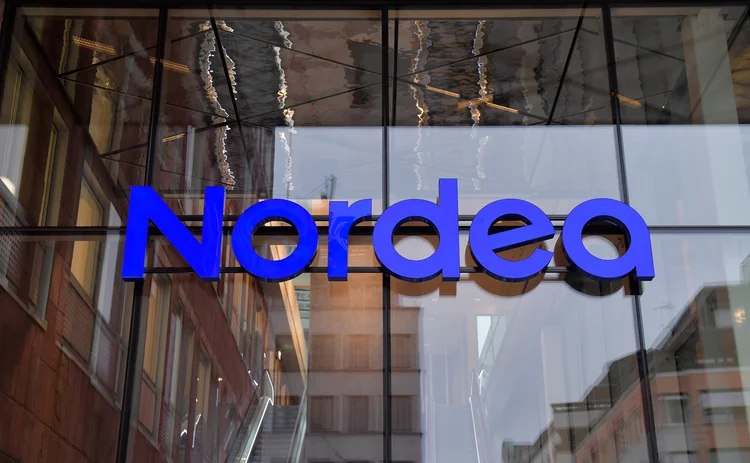
Quant investment firm of the year: Nordea Asset Management
Risk Awards 2021: focus on tail risk – and a little ice in the veins – helped Nordea stare down Covid

The remarkable thing about Asbjørn Trolle Hansen’s response to last year’s market turbulence was his composure.
But then, the portfolios at the multi-asset unit he runs at Nordea Asset Management are purpose-built to absorb extreme scenarios. The group’s primary focus is on managing tail risk, with “diversification in the front seat”, says Hansen. Unlike many risk premia strategies that tend to blow over in a strong wind, the Nordea unit’s combination of quantitative and qualitative layers lends it an agility that helps it thrive in adversity.
Protecting portfolios in the worst conditions means you have more risk capital available to deploy in normal times, Hansen explains. The ability to “stay on your feet” during volatile periods – and to put money back into losing trades before they rebound – matters even more in the V-shaped markets seen recently, he says. “You are able to take up opportunities to put on risk when markets are dislocated.”
So, without having seen the crisis coming, Hansen and his team were prepared when it did.
It’s an approach their clients appreciate. “You’ve got the rigour of a quant process, but you’ve also got a very good investment team sitting on top,” says one pension fund portfolio manager. Another says Hansen has a feel for how a purely quant process might lose its way. “He understands what is driving the model. It’s a control, rather than the team making big discretionary bets.”
They are also impressed by Hansen’s poise. In a year that’s been tough for the wider industry, he has remained unruffled. He is “superb – a very cool-headed guy,” says the pension fund client.
“People kept telling me it’d take another 50 years before we’d see markets like 2008,” says Hansen. “Then suddenly [Covid] was here. We were pretty happy about our preparations.”
Other managers in the alternative risk premia space suffered 20%+ losses and heavy client redemptions this year. Across the sector, unexpected correlations to equity markets became clear precisely as those markets tanked.
People kept telling me it’d take another 50 years before we’d see markets like 2008. Then suddenly [Covid] was here
Asbjørn Trolle Hansen, Nordea
But at the Nordea unit, the team’s flagship Alpha risk premia strategies were up in all four quarters. The unit, which has more than $100 billion in assets under management, saw over €1 billion more in investment inflows in 2020.
The firm’s Alpha Multi-Asset 10 fund was up 3.3% in March and 4.2% in April. It is the middle of three Ucits funds trading risk premia strategies across asset classes – the others target higher and lower volatilities. The riskiest of the three funds was up 12% year-to-date.
It’s no fluke. Nordea’s success continues a pattern of steady returns in rising markets and outperformance when prices fall. Over the past five years, the higher volatility fund beat the MSCI World Index by 19 basis points a month before fees. And during that time, for the 16 months in which the MSCI World index fell, the Nordea unit’s fund beat it by 4.56% a month.
Hansen says the success is a result of careful diversification. Nordea had strategies that did badly, such as emerging markets carry strategies and equity value, he says. But the firm’s statistical tail-risk hedges – defensive quant strategies that were built to capitalise on extreme market moves – more than made up for any lost ground.
One set of these trades rides trends in risk-on and risk-off investing, Hansen explains. He describes them as a risk-based version of trend-following, picking up and following trends specifically that maximise diversification. In Q1, the strategy picked up on the rush into gold stocks as investors sought refuge from the effects of the global pandemic.
Another group seeks out market dislocations and bets on their resolution – undervalued countries, sectors, strategies or instruments across asset classes. That group captured the rebound in markets in Q2.
In addition, Nordea’s multi-asset team works resolutely to craft strategies with tail risks in mind and then combines them into portfolios that neutralise correlation shifts in periods of stress. During the Covid tumult, everything behaved “pretty much as we’d expected”, says Hansen.
Six super-strategies
Nordea organises its 30 individual risk premia strategies into six buckets or ‘super-strategies’ – four of which correspond to equity, fixed income, currencies and statistical arbitrage strategies. These four are risk-balanced – within their groups, they balance exposure between strategies that do well in risk-on and risk-off conditions. The other two are directional buckets, containing momentum and mean-reversion strategies that can flip between risk-on and risk-off at different points in time.
Allocations are made across the buckets and to strategies within the buckets with an element of conviction – but only an element – the default position is to be equally balanced across buckets and strategies.
Critically, a strategy’s designation as risk-on or off rests largely on its behaviour in the extremes of the return distribution – where the gains and losses are the greatest. “Why use the data in the middle of the distribution when it’s the relationships in the tail that matter?” Hansen says.
The qualitative conviction scores, which are rated from one to three, allow the team to take account of market drivers that emerge in stress environments but are unlikely to have been considered in backtests or modelling – such as the effect of corporate leverage on stocks during the Covid pandemic.
Clients sometimes ask Hansen to attribute returns to one of two elements: quantitative or qualitative, he says. He can’t. “It’s fully integrated: 50-50.”
His team adjusts the conviction scores depending on market conditions. The past year has seen more adjustments than usual, but few big changes. “You could say if there are 30 dials, we changed 10 of them, some twice. But some were not touched,” Hansen says.
Why use the data in the middle of the distribution when it’s the relationships in the tail that matter?
Asbjørn Trolle Hansen, Nordea
The unit started the year with lower conviction for equity and credit stat-arb strategies and higher for fixed income. As the turmoil played out, it dialled down fixed income strategies that looked to have “exhausted” their potential and boosted allocations to the arbitrage strategies that did well in the rebound.
With the same philosophy in mind, the team avoids relying too heavily on backtests, Hansen says. Instead, they build in a view of how the strategies would perform in different market conditions when creating pricing models for individual premia.
Its version of the value strategy, for example, incorporates forecasts of future earnings at company and market level, seeking bargains only where earnings projections look solid. The approach helps avoid the so-called value trap, when value strategies pick up companies that are cheap but heading for trouble.
Hansen is dismissive of quants that ignore the fundamental underpinnings of strategies. “If you have an economic hypothesis about why you get performance from a strategy and what risk you’re taking, you should be able to formulate that in a model,” he says. “You should be able to validate your belief. If you think in value that earnings yield spreads should predict performance, you should write your equation like that.”
To surrender the chance to make discretionary calls wastes insight into how the tools and risk premia behave, he says, particularly when times are tough. “We build the strategies ourselves. Sometimes that takes two or three years. We learn a lot on the way.”
For Hansen, the experience this year hasn’t been entirely novel. One of the first tests for the Nordea unit’s approach was the so-called quant quake in 2007, in which firms lost as much as 30% in less than a week. But for Hansen and his team, the quake was similarly “uneventful”, he says.
The financial crisis provided another test, and a similar story. The funds struggled in 2008 but recovered well in 2009. Returns for the Alpha 15 strategy for the three years from 2007 to 2009 were 8.6% annualised before fees. “The tail hedging concept proved itself. There was no meltdown,” Hansen recalls.
And while this year’s events may have come as a surprise, at Nordea they didn’t come as a shock. Asked about dealings with Hansen over the past 12 months, when most of the industry was in crisis, one client simply says: “I’ve not had much contact to be honest. There’s been no need.”
Only users who have a paid subscription or are part of a corporate subscription are able to print or copy content.
To access these options, along with all other subscription benefits, please contact info@risk.net or view our subscription options here: http://subscriptions.risk.net/subscribe
You are currently unable to print this content. Please contact info@risk.net to find out more.
You are currently unable to copy this content. Please contact info@risk.net to find out more.
Copyright Infopro Digital Limited. All rights reserved.
You may share this content using our article tools. Printing this content is for the sole use of the Authorised User (named subscriber), as outlined in our terms and conditions - https://www.infopro-insight.com/terms-conditions/insight-subscriptions/
If you would like to purchase additional rights please email info@risk.net
Copyright Infopro Digital Limited. All rights reserved.
You may share this content using our article tools. Copying this content is for the sole use of the Authorised User (named subscriber), as outlined in our terms and conditions - https://www.infopro-insight.com/terms-conditions/insight-subscriptions/
If you would like to purchase additional rights please email info@risk.net
More on Awards
Joining the dots: banks leverage tech advancements for the future of regulatory reporting
The continued evolution of regulatory frameworks is creating mounting challenges for capital markets firms in achieving comprehensive and cost-effectiveawa compliance reporting. Regnology discusses how firms are starting to use a synthesis of emerging…
Markets Technology Awards 2024 winners' review
Vendors spy opportunity in demystifying and democratising – opening up markets and methods to new users
Derivatives house of the year: JP Morgan
Risk Awards 2024: Response to regional banking crisis went far beyond First Republic
Risk Awards 2024: The winners
JP Morgan wins derivatives house, lifetime award for El Karoui, Barclays wins rates
Best product for capital markets: Murex
Asia Risk Awards 2023
Technology vendor of the year: Murex
Asia Risk Awards 2023
Best structured products support system: Murex
Asia Risk Awards 2023
Energy Risk Asia Awards 2023: the winners
Winning firms demonstrate resiliency and robust risk management amid testing times
Most read
- Industry urges focus on initial margin instead of intraday VM
- For a growing number of banks, synthetics are the real deal
- Did Fed’s stress capital buffer blunt CCAR?







